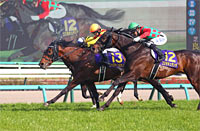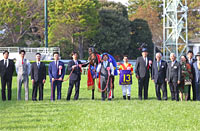Satsuki Sho (Japanese 2000 Guineas) (G1) - Data Analysis
First leg of the classic Triple Crown
Looking at the previous race of the last 10 winners, we find that the majority of winners (five) came from the Kyodo News Service Hai (Tokinominoru Kinen), two from the Hopeful Stakes, two from the Spring Stakes, and one from the Mainichi Hai. As we approach this exhilarating race, let’s now analyze the data for the last 10 years.
Strong performance by runners that triumphed in debut race
Of the 30 Top 3 finishers over the last 10 years, 25 had secured a victory in their debut race. In addition, if we limit our analysis to the four years since 2019, we observe that all 12 Top 3 finishers had won their debut race. Conversely, runners that had been defeated in their debut race had low success ratios, and runners that had been beaten to 4th or lower produced zero Top 3 finishers. [Table 1]
[Table 1] Performance by finish in debut race (last 10 years)
| Finish in debut race |
Performance
[1st-2nd-3rd-4th or lower] |
Win
ratio |
Top 2
ratio |
Top 3
ratio |
| 1st |
7-9-9-68 |
7.5% |
17.2% |
26.9% |
| 2nd |
2-1-0-29 |
6.3% |
9.4% |
9.4% |
| 3rd |
1-0-1-14 |
6.3% |
6.3% |
12.5% |
| 4th or lower |
0-0-0-32 |
0% |
0% |
0% |
Focus on runners backed as 1st favorite in previous race
Looking at performances by runners over the last 10 years in terms of favoritism in the previous race, we find that 18 of the 30 Top 3 finishers had been backed as 1st favorite in their previous race. Runners in this group achieved high success ratios, and we also find a significant gap in success ratios between these runners and those that had been backed as 2nd favorite or lower in their previous race. The Satsuki Sho (Japanese 2000 Guineas) brings together runners coming from graded races (such as trial or prep races) contested by many top performers, and a backing as 1st favorite in such a race is therefore a sign of high expectations of a runner’s capabilities. This year, we should again focus on runners that fit the description above. [Table 2]
[Table 2] Performance by favoritism in previous race (last 10 years)
| Favoritism in previous race |
Performance
[1st-2nd-3rd-4th or lower] |
Win
ratio |
Top 2
ratio |
Top 3
ratio |
| 1st favorite |
6-7-5-28 |
13.0% |
28.3% |
39.1% |
| 2nd favorite |
1-1-1-22 |
4.0% |
8.0% |
12.0% |
| 3rd favorite |
1-0-1-19 |
4.8% |
4.8% |
9.5% |
| 4th favorite |
1-1-0-19 |
4.8% |
9.5% |
9.5% |
| 5th favorite |
0-1-2-13 |
0% |
6.3% |
18.8% |
| 6th-9th favorite |
1-0-1-36 |
2.6% |
2.6% |
5.3% |
| 10th favorite or lower |
0-0-0-6 |
0% |
0% |
0% |
Watch position when passing 4th corner in previous race
Looking at performances by runners over the last 10 years in terms of position when passing the 4th corner in their previous race, we note that runners positioned 2nd-3rd produced five winners, while runners positioned 4th-5th delivered three winners. In addition, runners ranking 2nd-3rd or 4th-5th when passing the 4th corner in their previous race achieved the highest Top 3 ratios. In other words, we should focus on runners that occupied the front of the pack in their previous race. [Table 3]
[Table 3] Performance by position when passing 4th corner in previous race (last 10 years)
Position when passing
4th corner in previous race |
Performance
[1st-2nd-3rd-4th or lower] |
Win
ratio |
Top 2
ratio |
Top 3
ratio |
| Leader |
0-2-1-17 |
0% |
10.0% |
15.0% |
| 2nd-3rd |
5-3-2-42 |
9.6% |
15.4% |
19.2% |
| 4th-5th |
3-1-5-36 |
6.7% |
8.9% |
20.0% |
| 6th or lower |
2-4-2-48 |
3.6% |
10.7% |
14.3% |
Victory in turf graded race is desirable
Looking at performances by runners over the last 10 years in terms of their highest finish in a graded turf race, we note that 24 of the 30 Top 3 finishers had previously triumphed in a graded turf race. In addition, runners with a highest finish of 2nd produced two winners and two 3rd-place finishers, while runners with a highest finish of 3rd or below delivered zero winners and two runners-up. Meanwhile, runners who had previously not entered a graded turf race consistently finished outside the Top 3. Given that the Satsuki Sho brings together generational racing talent, a track record in graded races can be considered an essential determinant of success. [Table 4]
[Table 4] Performance by highest finish in graded turf race (last 10 years)
Highest finish in graded
turf race |
Performance
[1st-2nd-3rd-4th or lower] |
Win
ratio |
Top 2
ratio |
Top 3
ratio |
| 1st |
8-8-8-66 |
8.9% |
17.8% |
26.7% |
| 2nd |
2-0-2-24 |
7.1% |
7.1% |
14.3% |
| 3rd or lower |
0-2-0-29 |
0% |
6.5% |
6.5% |
No graded turf race entered
in the past |
0-0-0-24 |
0% |
0% |
0% |
Seek out the winner!
Check win conditions in the past
The five winners since 2018 all had experience of winning a 1-win class or open-class race with a time difference of 0.3s or more with the runner-up in that race. When predicting the race winner, we should therefore check the win conditions in a 1-win class race or open-class race. [Table 5]
[Table 5] Winners’ highest time difference with runner-up in a 1-win class or open-class race in which they were victorious (last five years)
| Year |
Winner |
Highest time difference |
| 2018 |
Epoca d’Oro |
0.6s |
| 2019 |
Saturnalia |
0.3s |
| 2020 |
Contrail |
0.8s |
| 2021 |
Efforia |
0.4s |
| 2022 |
Geoglyph |
0.7s |
(Michio Kawano)
|




















